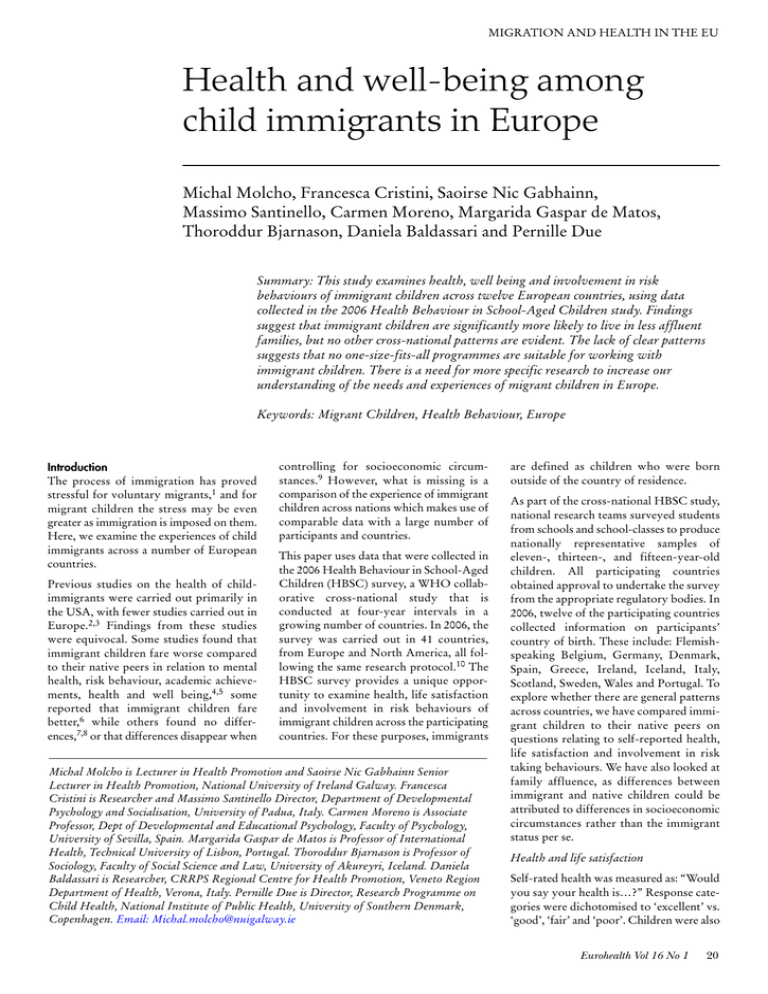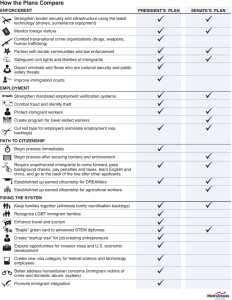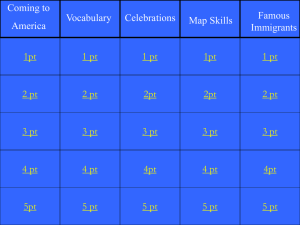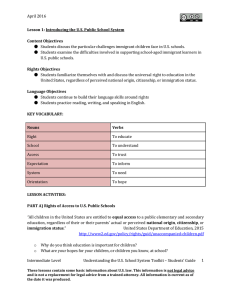Health and well-being among child immigrants in Europe
advertisement

MIGRATION AND HEALTH IN THE EU Health and well-being among child immigrants in Europe Michal Molcho, Francesca Cristini, Saoirse Nic Gabhainn, Massimo Santinello, Carmen Moreno, Margarida Gaspar de Matos, Thoroddur Bjarnason, Daniela Baldassari and Pernille Due Summary: This study examines health, well being and involvement in risk behaviours of immigrant children across twelve European countries, using data collected in the 2006 Health Behaviour in School-Aged Children study. Findings suggest that immigrant children are significantly more likely to live in less affluent families, but no other cross-national patterns are evident. The lack of clear patterns suggests that no one-size-fits-all programmes are suitable for working with immigrant children. There is a need for more specific research to increase our understanding of the needs and experiences of migrant children in Europe. Keywords: Migrant Children, Health Behaviour, Europe Introduction The process of immigration has proved stressful for voluntary migrants,1 and for migrant children the stress may be even greater as immigration is imposed on them. Here, we examine the experiences of child immigrants across a number of European countries. Previous studies on the health of childimmigrants were carried out primarily in the USA, with fewer studies carried out in Europe.2,3 Findings from these studies were equivocal. Some studies found that immigrant children fare worse compared to their native peers in relation to mental health, risk behaviour, academic achievements, health and well being,4,5 some reported that immigrant children fare better,6 while others found no differences,7,8 or that differences disappear when controlling for socioeconomic circumstances.9 However, what is missing is a comparison of the experience of immigrant children across nations which makes use of comparable data with a large number of participants and countries. This paper uses data that were collected in the 2006 Health Behaviour in School-Aged Children (HBSC) survey, a WHO collaborative cross-national study that is conducted at four-year intervals in a growing number of countries. In 2006, the survey was carried out in 41 countries, from Europe and North America, all following the same research protocol.10 The HBSC survey provides a unique opportunity to examine health, life satisfaction and involvement in risk behaviours of immigrant children across the participating countries. For these purposes, immigrants Michal Molcho is Lecturer in Health Promotion and Saoirse Nic Gabhainn Senior Lecturer in Health Promotion, National University of Ireland Galway. Francesca Cristini is Researcher and Massimo Santinello Director, Department of Developmental Psychology and Socialisation, University of Padua, Italy. Carmen Moreno is Associate Professor, Dept of Developmental and Educational Psychology, Faculty of Psychology, University of Sevilla, Spain. Margarida Gaspar de Matos is Professor of International Health, Technical University of Lisbon, Portugal. Thoroddur Bjarnason is Professor of Sociology, Faculty of Social Science and Law, University of Akureyri, Iceland. Daniela Baldassari is Researcher, CRRPS Regional Centre for Health Promotion, Veneto Region Department of Health, Verona, Italy. Pernille Due is Director, Research Programme on Child Health, National Institute of Public Health, University of Southern Denmark, Copenhagen. Email: Michal.molcho@nuigalway.ie are defined as children who were born outside of the country of residence. As part of the cross-national HBSC study, national research teams surveyed students from schools and school-classes to produce nationally representative samples of eleven-, thirteen-, and fifteen-year-old children. All participating countries obtained approval to undertake the survey from the appropriate regulatory bodies. In 2006, twelve of the participating countries collected information on participants’ country of birth. These include: Flemishspeaking Belgium, Germany, Denmark, Spain, Greece, Ireland, Iceland, Italy, Scotland, Sweden, Wales and Portugal. To explore whether there are general patterns across countries, we have compared immigrant children to their native peers on questions relating to self-reported health, life satisfaction and involvement in risk taking behaviours. We have also looked at family affluence, as differences between immigrant and native children could be attributed to differences in socioeconomic circumstances rather than the immigrant status per se. Health and life satisfaction Self-rated health was measured as: “Would you say your health is…?” Response categories were dichotomised to ‘excellent’ vs. ‘good’, ‘fair’ and ‘poor’. Children were also Eurohealth Vol 16 No 1 20 MIGRATION AND HEALTH IN THE EU asked about their perceived life satisfaction: “Here is a picture of a ladder, the top of the ladder ‘10’ is the best possible life for you and the bottom, ‘0’ is the worst possible life. In general, where on the ladder do you feel you stand at the moment?” Answers were dichotomised to 9–10 as high level of life satisfaction vs. 0–8. Risk behaviours Five areas of risk behaviour are also considered here. Participation in fights was measured using the question: “During the past twelve months, how many times were you in a physical fight?” This question was dichotomised into ‘never’ vs. ‘1 time or more’. Bullying was measured using two questions: “How often have you been bullied at school in the last couple of months?” and “How often have you taken part in bullying another student(s) at school in the last couple of months?” Both questions were dichotomised to ‘more than twice’ vs. ‘twice or less’. Smoking was measured using the question: “How often do you smoke tobacco at present?” This question was dichotomised to ‘weekly or more’ vs. ‘less than weekly’. Students were also asked about their history of drunkenness; “Have you ever had so much alcohol that you were really drunk?” with responses dichotomised to ‘twice or more’ vs. ‘never or once’. Family affluence Young people’s socioeconomic status was measured using the Family Affluence Scale (FAS).11 This scale is based on four material conditions of the households in which young people live, including: family vehicle ownership, having their own bedroom, number of family holidays and number of family computers. The scale was used to create three variables: low, middle and high family affluence. Findings The proportion of immigrant children in the sample varies from 4% in Wales to 11% in Ireland (see Table 1). In all countries, except for Ireland and Scotland, the level of family affluence reported by immigrant children is lower than that of their native peers (Table 2), and immigrant children are found to be over-represented in less affluent households and under-represented in more affluent households. This finding stands out as the strongest, most consistent difference between child immigrants and their native peers and is similar to findings previously reported.7,12 This suggests that further analyses must control 21 Eurohealth Vol 16 No 1 Table 1: Distribution of foreign-born children by country, gender and age group; percentage (number of children) Country All Boys Girls 11 y 13 y 15 y Belgium (Flemish) 4.8 (206) 5.1 (111) 4.5 (95) 3.2 (41) 5.6 (78) 5.4 (87) Denmark 5.5 (313) 5.6 (153) 5.4 (160) 4.1 (85) 5.4 (110) 7.2 (112) Germany 6.5 (468) 6.5 (237) 6.4 (231) 5.1 (114) 6.6 (160) 7.3 (187) Greece 7.2 (265) 6.0 (106) 8.1 (159) 4.3 (47) 7.9 (93) 8.8 (124) Iceland* 6.5 (122) 6.1 (58) 6.9 (64) Ireland 11.0 (536) 10.5 (260) 11.5 (276) 10.1 (138) 10.5 (187) 12.2 (206) Italy 4.8 (190) 5.0 (100) 4.6 (90) 3.6 (45) 4.7 (63) 5.8 (77) Portugal 5.8 (235) 4.8 (103) 5.8 (132) 5.3 (68) 5.5 (82) 5.2 (85) Scotland 8.3 (515) 8.3 (253) 8.4 (262) 6.6 (111) 8.6 (194) 9.4 (205) Spain 8.6 (737) 8.2 (358) 8.4 (379) 9.8 (292) 7.9 (223) 7.3 (222) Sweden 4.7 (207) 5.1 (111) 4.3 (96) 3.9 (58) 4.2 (57) 5.8 (88) Wales 4.0 (177) 3.9 (84) 4.2 (93) 4.7 (70) 3.9 (59) 3.3 (45) 6.5 (121) * data available for 15 year olds only for these differences in family affluence when comparing immigrant children with their native peers on aspects of health, life satisfaction and risk behaviour. Once we take the differences in gender, age and family affluence into account, immigrant children do not significantly differ from their peers in their health and life satisfaction in most countries, with the notable exception of Ireland and Wales. In Wales immigrant children are 1.5 times more likely to report excellent health (p<0.05) and in Ireland they were also significantly more likely to report high life satisfaction compared to their native peers. These findings suggest that despite generally reporting lower levels of family affluence, in most countries immigrant children did not report poorer health or lower life satisfaction. This finding could be viewed as counterintuitive, if we consider that many studies have shown the negative influence of socioeconomic hard- ships on adolescent development.13 This phenomenon has previously been labeled as ‘’the immigrant paradox’’.14 Another important aspect of immigrant children’s life that is often addressed is involvement in risk behaviours. Here too no clear and consistent cross-national patterns emerged. In some countries immigrant children were more likely to report alcohol use and in others they were less likely to report drunkenness or smoking behaviour (see Table 3). Bullying victimisation and bullying perpetration were more prevalent among immigrant children in Ireland, Scotland, Spain and Italy, but bullying was less prevalent among immigrant children in Greece, with no differences in the other countries. Similarly, physical fighting was more prevalent among immigrant children in Germany, Greece, Italy, Spain and Sweden, but not in the remaining seven countries (Table 3). These different patterns in different coun- MIGRATION AND HEALTH IN THE EU Table 2: Distribution of Family Affluence Scale (FAS) by foreign-born status: percentage Country Foreign-born Natives Significance level High FAS Mid FAS Low FAS High FAS Mid FAS Low FAS Belgium (Flemish) 44.5 37.7 17.8 47.2 42.7 10.0 P<0.01 Denmark 42.9 39.2 17.9 51.4 41.4 7.3 P<0.001 Germany 22.1 47.0 30.9 48.5 39.5 12.0 P<0.001 Greece 11.4 41.4 47.1 28.6 47.7 23.6 P<0.001 Iceland 62.9 28.4 8.6 70.7 27.5 1.8 P<0.001 Ireland 21.5 54.9 21.5 20.0 56.4 23.6 N.S. Italy 27.0 37.4 35.3 32.2 46.1 20.4 P<0.001 Portugal 22.6 40.1 32.9 32.0 43.4 24.4 P<0.005 Scotland 48.0 38.2 13.8 42.8 40.8 16.3 N.S. Spain 22.3 42.7 35.0 40.9 46.1 13.1 P<0.001 Sweden 33.5 43.8 22.7 57.0 37.3 5.7 P<0.001 Wales 31.6 41.8 26.6 45.6 41.4 13.0 P<0.001 Table 3: Models of logistic regression: odds ratios of involvement in risk behaviours predicted by foreign-born status, by country Country Was in a fight Been bullied Bullied others Weekly smoking Been drunk Belgium (Flemish) 1.24 0.89 1.54 1.10 0.93 Denmark 1.20 0.87 1.36 0.88 0.37*** Germany 1.93*** 0.79 0.93 0.90 1.27 Greece 1.56** 0.89 0.69* 0.87 1.60* Iceland 0.78 0.70 0.44 0.64 0.88 Ireland 1.00 1.39* 1.24 1.13 0.85 Italy 1.59** 1.12 1.89** 0.83 1.07 Portugal 1.13 1.33 1.38 1.08 1.10 Scotland 1.02 1.44* 1.05 1.24 0.92 Spain 1.27** 1.98*** 1.67*** 0.65* 1.08 Sweden 1.50* 1.23 2.53*** 1.31 1.05 Wales 0.79 1.30 1.03 0.60 0.54** *p<0.05; ** p<0.01; ***p<0.001 All analyses are controlled for gender, age and family affluence tries mean that, despite the similarities in the samples and the way that things have been measured, there is no one story that can be told about the health of immigrant children across Europe. Limitations The HBSC study provides a unique opportunity to gain further cross-national understanding of child immigrants, using similar methods and a standardised questionnaire across a range of countries in different regions of Europe. Nevertheless, there are some limitations to these data. First and foremost, the overall study is aimed at the general population and not at immigrants, resulting in relatively low absolute numbers of immigrant children in the study, but also in lack of specific information about the immigrant population. The relatively low number of immigrant children in the sample does not allow stratification by country of origin. Similarly we cannot undertake a more thorough analysis of cultural differences and potential conflicts or interactions between different groups of immigrants and between the country of origin and country of destination, thus preventing us from making recommendations regarding specific minorities. Unfortunately, we also cannot differ between immigrants and returning citizens whose children were born while away from their native country. There is a clear need for specific studies to be conducted to facilitate these more nuanced views to be explored. Conclusions Given the absence of general patterns, this study highlights the complexity of the immigration phenomenon. Of all the variables examined, the only consistent finding is the low affluence of immigrant children across countries. This is in itself an important finding, given the widespread influence of socioeconomic factors on the lives of children and families. These findings suggest that there is a need for more focused studies on immigrants, looking at different groups and at country of origin and of residence, but also the need to engage in participatory studies allowing the voice of immigrants to be heard. It is clear that we need to promote tolerance towards diversities in societies and to create mechanisms that allow for better integration of immigrant children in society. The article also provides insights into issues that could have implications for research, policy and practice. Primarily the Eurohealth Vol 16 No 1 22 MIGRATION AND HEALTH IN THE EU need to use the social determinants of health approach to immigrant child wellbeing. Two examples are noted: Turkish and Dutch children. Social Psychiatry and Psychiatric Epidemiology 1997;32:477–84. – Noting that immigrant children are found to be over-represented in less affluent households, it is important that (a) migration policy provide migrant families with equitable access to social protection services, and that (b) social protection policies foster and encourage equitable access to public services and opportunities. Such support and social protection needs to begin in childhood and be provided across the life course. 6. Acevedo-Garcia D, Pan J, Jun H, Osypuk TL, Emmons KM. The effect of immigrant generation on smoking. Social Science & Medicine 2005;61:1223–42. – Given the complexities of the migration phenomena, international comparison of data on migrant health is challenging and can lead to disparate results. While it is important nevertheless to continue these efforts at international level, it is first and foremost essential to scale up investment in information systems at national and sub-national level that look at health inequities, including by migrant status. Such information can then be taken into consideration in the design of policies and programmes, in the health sector and beyond, with particular usefulness for primary health care level in areas serving migrant communities and other populations that may face higher levels of social exclusion. 7. Vollebergh WAM, Ten Have M, Dekovic M et al. Mental health in immigrant children in the Netherlands. Social Psychiatry and Psychiatric Epidemiology 200540:489–96. 8. Beiser M, Hou F, Hyman I, et al. Poverty, family process and the mental health of immigrant children in Canada. American Journal of Public Health 2002;92:220–27. 9. Matos MG, Gonçalves A, Gaspar T. Adolescentes estrangeiros em Portugal: uma questão de saúde (Foreign adolescents in Portugal: a question of health). Psicologia, Saúde e Doenças 2004;5(1):75–85. 10. Currie C et al (eds). Inequalities in young people’s health: HBSC International Report from the 2005/2006 Survey. Copenhagen: WHO, 2008. 11. Currie C et al. Researching health inequalities in adolescents: The development of the Health Behaviour in School-Aged Children (HBSC) Family Affluence Scale. Social Science & Medicine 2008;66(6):1429–36. 12. The Urban Institute. Children of Immigrants: Fact and Figures. Office of Public Affairs Washington DC, May 2006. 13. Duncan GJ, Brooks-Gunn J. Family poverty, welfare reform, and child development. Child Development 2000;71:188–96. 14. Garcia Coll C. The Immigrant Paradox: Critical Factors in Cambodian Students’ Success. Paper presented at the 2005 Biennial meeting of the Society for Research in Child Development. Atlanta, Georgia, 7–10 April 2005. ACKNOWLEDGMENT Health Behaviour in School-Aged Children (HBSC) is a World Health Organization / European Region collaborative study. The international coordinator of the 2005/2006 study was Candace Currie, University of Edinburgh, Scotland and the data bank manager was Oddrun Samdal, University of Bergen, Norway. We thank the HBSC International Coordinating Centre, University of Edinburgh and all of the investigators of the participating countries. NEW BOOK REFERENCES 1. Harrison G, Glazebrook C, Brewin J, et al. Increased incidence of psychotic disorders in migrants from the Caribbean in the United Kingdom. Psychological Medicine 1997;27:799–807. Tackling Chronic Disease in Europe: Strategies, Interventions and Challenges Reinhard Busse, Miriam Blümel, David Scheller-Kreinsen and Annette Zentner 2. Berry JW, Phinney JS, Sam DL, Vedder P (eds). Immigrant Youth in Cultural Transition: Acculturation, Identity and Adaptation Across National Contexts. Mahwah, NJ: Lawrence Erlbaum Associates, 2006. 3. Strohmeier D, Schmitt-Rodermund E. Immigrant youth in European countries: The manifold challenges of adaptation. European Journal of Developmental Psychology 2008;5(2):129–37. 4. Vieno A, Santinello M, Lenzi M, Baldassari D, Mirandola M. Health status in Immigrants and native early adolescents in Italy. Journal of Community Health 2009;34(3):181–87. 5. Bengi-Arslan L, Verhulst FC, van der Ende J, Erol N. Understanding childhood (problem) behaviour from a cultural perspective: comparison of problem behaviour and competencies in Turkish immigrant, 23 Eurohealth Vol 16 No 1 Observatory Studies Series No. 20 Copenhagen: World Health Organization, 2010 111 pages ISBN 9789289041928 Chronic conditions and diseases are the leading cause of mortality and morbidity in Europe, accounting for 86% of total premature deaths. Furthermore, research suggests that complex conditions such as diabetes and depression will impose an even greater health burden in the future – and not only for rich and older people in high-income countries, but increasingly for the poor as well as those in low- and middle-income countries. The epidemiological and economic analyses in the first part of the book suggest that policy-makers should make chronic disease a priority. This book highlights the issues and focuses on the strategies and interventions that policy-makers have at their disposal to tackle this increasing challenge.







